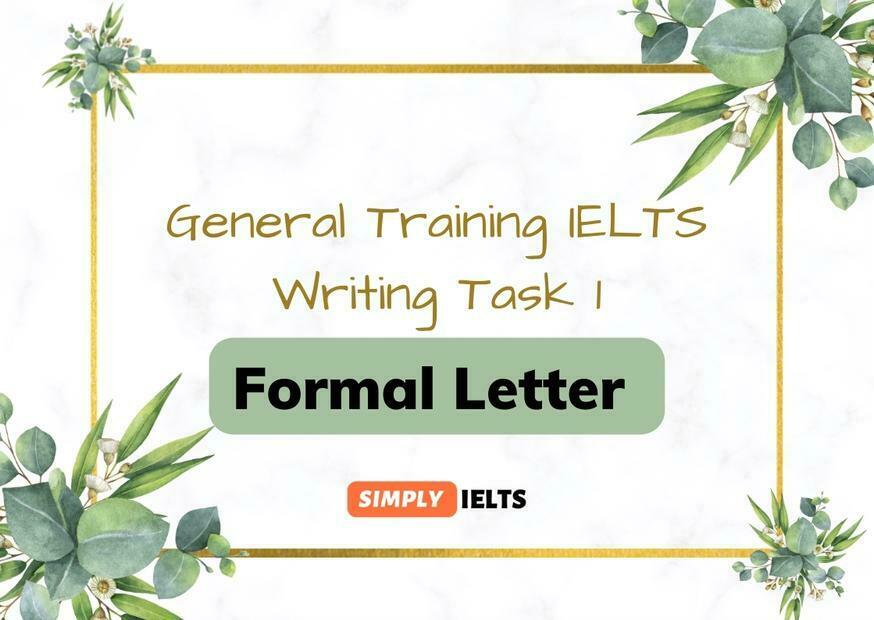How to begin the IELTS formal letters on General Training module?

Most IELTS General Training students have learnt how to write formal letters in school. They remember the exact format taught to them.
However, when they read the IELTS Letter tasks, they see that IELTS wants them to start the letter with ‘Dear…’. They did not anticipate thinking about the actual contents of the letter! That’s when the hands shoot up in class. “How do I start the letter?”
In the first paragraph of the IELTS letter, you must introduce yourself and write the purpose of the letter. Since this is a formal letter and you have never met the reader, introducing yourself at the beginning is essential.
Then you must write about why you are writing the letter. This will set the tone of the rest of the letter. Both of these points need to be present in the first paragraph as an introduction.
Now to understand how to begin the formal letters on IELTS consider a sample IELTS task.
A sample IELTS Letter task
You should spend about 20 minutes on the task.
You have just read an article in a newspaper which contained some information about your town, which is incorrect.
Write a letter to the editor of the magazine. In your letter,
- Correct the information in the article
- Explain why it is essential for the newspaper to give correct information
- Suggest what the newspaper should do about this situation
Write at least 150 words. You do NOT need to write any addresses:
Begin your letter as follows
Dear Sir or Madam,
Analysis of the IELTS formal letter task
Now, how many of us really know the editor of the magazine? Hardly any of us. Moreover, the last instruction asks us to begin the letter with ‘Dear Sir or Madam’.
It means not only do we not know the name of the editor, but we do not know the gender as well. So, it is customary that we or in this case the write introduces himself or herself.
Step 1: Always Begin IELTS Formal Letter With Your Name
Students often ask why they have to write their name in the first paragraph when they are going to write their name in the sign off anyway.
Well, if you receive a letter from an unknown person, wouldn’t you like to know who they are? You wouldn’t first read the end of the letter to look for their name and then continue from the top, right? It is human nature first to introduce ourselves to strangers and then tell them why we are contacting them. The same has to be done in a letter as well.
Remember, IELTS is about communication skills more than the actual English language itself!
Step 2: Then Write the Purpose of the IELTS Formal Letter.
If you receive a phone call from an unknown person, what would you like to know from him or her? The caller’s name and the purpose of the call. Right? Now since you have already declared your name, all you need to convey is why are you writing the letter.
Following are a few sample IELTS Letter Writing Tasks, along with the first paragraph.
Task 1
You should spend about 20 minutes on this task.
You have recently ordered an item through the Internet, but you are not happy with the purchase.
Write to the company. In your letter:
• describe what you purchased,
• explain why you are not happy with the purchase,
• tell them what you would like them to do about the situation.
Begin your letter as follows: Write at least 150 words.
You do NOT need to write any addresses.
Dear Sir or Madam,
Answer 1:
“Dear Sir or Madam,
I am Rahul Singh from Pune and a regular buyer at webstore.com, your online shopping portal. I am writing this letter to express my disappointment with a recent purchase (order number 7298883).”
As you see here, the writer has added another information in the introduction – the order number. Even though the task did not ask for it, if you were actually to write to an e-commerce website, you would have to mention the Order Number. Such additional information makes the letter seem authentic; something IELTS will favour.
Question 2:
You should spend about 20 minutes on this task.
Your car insurance company has told you that they are going to increase the amount you have to pay in insurance for your car each month. You are not happy about this.
Write a letter to your insurance company. In your letter explain
- Why you are writing to them
- Why you think insurance should not be increased
- What you want them to do
Write at least 150 words
You do NOT need to write any addresses
Begin your letter as follows:
Dear _______,
Answer 2:
“Dear Sir or Madam,
I am Mohmmad Khan, who holds a Car Insurance (LIC1528) of your company. I am responding to your letter updating me about the increased insurance premium for my car from next month.”
The writer here does not mention that he is not happy about the rise in insurance premium. Now, logically, no one is happy when they have to pay more for a service they were getting for cheaper. No one would even write a letter to the company praising this action either.
Therefore it is assumed that if you are writing to the insurance company about the rise in prices, you are not happy about it.
Conclusion:
If you look at IELTS Writing Task 1 (General Training) or letters, you will see that these letters are real-life situations that have needed us to reach out to a company for some reason.
So IELTS expects you to write these letters as if you are actually reaching out to the company.
This means writing your name and the purpose of the letter in the first paragraph and then writing about the three points mentioned in the question in the subsequent paragraphs.





Responses